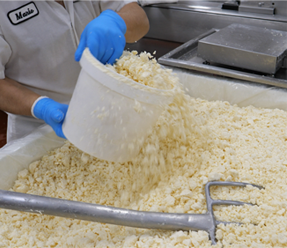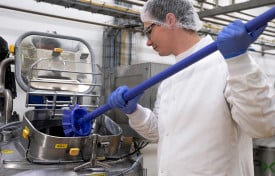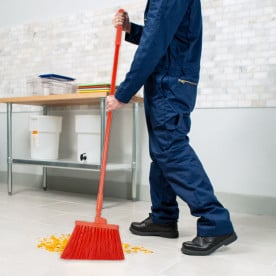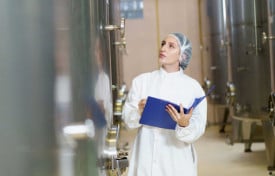Learning Center

Now is the time to start thinking about organizing, identifying, and labeling your inventory and storage areas in the New Year. Creating an expected “home” or centralized location for supplies, will allow your team members to quickly find the products they need.
In addition, having well-organized and labeled inventory allows your staff to quickly see products that are missing or need reordering, and creates efficiencies in your inventory management process. Take your organization one step further by including replenishment information clearly printed on labels—including fill to levels, descriptions, units of measure, manufacturer part numbers, and more. This will ensure that reordering information is contained in a universal, visible manner verses critical information being held by a few specific employees.

This content emphasizes the significance of proper disinfection in the food industry, particularly in food processing equipment, to eliminate pathogens and ensure a hygienic environment. While traditional chemicals have been integral in the cleaning process, Ultraviolet-C (UV-C) light has emerged as an effective complementary disinfection method. UV-C light utilizes short wavelengths to rapidly deactivate and eliminate microorganisms such as bacteria, mold, and viruses. After a thorough standard cleaning, UV-C light is employed to reach into hard-to-reach places, enhancing the effects of traditional cleaning solutions and providing superior sanitation. The content introduces the Aurora UV Disinfecting Device from SMS Technologies as a state-of-the-art UV-C technology for efficient and easy cleaning of food processing equipment. Additionally, the nUVaCleanTM UV Pipette Carousel is highlighted as the first pipette rack that not only organizes and protects pipettes but also destroys over 99%
For many people throughout the United States, hunting wild game is a beloved pastime--whether for the enjoyment of the outdoors, thrill of the hunt, or an economical way to obtain food. Along with this hobby comes many safety precautions. Just as a hunter should be trained in firearm safety and first aid procedures, food safety is also important. Educating one’s self on the dangers of foodborne illness is one step closer to harvesting a game animal for safe consumption.
Know The Risks
Harmful bacteria such as Salmonella and E.coli can live in raw or undercooked game meats. It is important to note the stages in which contamination may occur, and what steps can be taken to ensure you have processed your animal in the safest means possible.
Contamination can occur through the initial wound sustained by a bullet or an arrow. It is best to avoid hitting or puncturing the area around the stomach and intestines, as this would result in spoiling much of
The score everyone wants to achieve for any “test” we have taken (from grade school through post-secondary education) is 100%. One Hundred is also the score that any company involved with the Safe Quality Food (SQF) standard wants to achieve.
But…What does 100% mean in SQF?
Does it mean that your company is doing everything right? What is involved in getting that score? What does it take to maintain it?
First, congratulations on becoming SQF certified. Learning the SQF code and preparing your facility takes time. On average it’s about 6 months from the time a company opts into the program until the time they earn the certification. Much of this time is spent preparing for the audit through paperwork trails and training programs. The audit itself is a very short process in and of itself. The average audit is only 2-3 days; which means a company is preparing for the audit the other 362 days of the year.
Maxiren® XDS and Nelson-Jameson make a GOUDA couple!
You FETA BRIE-LIEVE IT!
And yes, we are together for the long haul.
Maxiren® XDS is a fermentation produced chymosin (FPC) that protects, preserves, and optimizes the required coagulant in the cheese process helping cheese reach its full potential of GRATE taste and big smiles. There is an increase of flexibility in the cheese production when Maxiren® XDS is involved. This extraordinary coagulant has a high specificity which lowers the amount of coagulant required, and aids in slowing the breakdown of cheese proteins, resulting in enhanced cheese textures. The enriched texture maintains a longer shelf life which allows shredding, slicing, and dicing to be smooth, natural, and more efficient through different cheese stages.
As most in the food industry know, looking clean isn't the same as actually being clean. Though a new cleaning tool may appear to be ready for use right away, especially those sealed in plastic pouches, they need to be prepped for their first use. Here are a few steps that should be taken to ensure all new tools are ready for use in food production facilities:
Remove Labels
It is essential to completely remove any label and adhesive, as the sticky
Nelson-Jameson strives to not only be a resource of products, programs, services, and industry expertise, but to also be of service to the food industry and focus on the mutually shared goal of food safety and quality. This allows us to work with a whole host of professional organizations, academic programs, regulatory agencies, etc. Over the past several months, we have enjoyed engaging and becoming active with the Innovation Center for U.S. Dairy Food Safety Team. You may or may not be familiar with this volunteer organization, and even if you are, you may be surprised by the remarkable scope of resources available...
 The Innovation Center for US Dairy is a consortium of dairy industry producers, educators, and organizations
The Innovation Center for US Dairy is a consortium of dairy industry producers, educators, and organizations
Ensuring the proper application and removal of lids is paramount for preserving the longevity of your buckets and lids while maintaining the secure containment of contents. Incorrectly applied lids pose a risk of product loss. The precise application of lids not only safeguards the contents from potential contamination but also plays a crucial role in preventing spills or leaks. Consistent adherence to correct application and removal procedures not only extends the lifespan of the containers but also contributes to overall operational efficiency, minimizing the likelihood of product wastage and ensuring a reliable containment system for your valuable goods.
Ultraviolet-C (UV-C) has been a part of the food processing industry for over 50 years. The power of this unique form of light may be invisible to the human eye, but it's impact on sterilization can be felt far and wide. Unlike the costly and corrosive chemicals that are traditionally used in the sterilization process, UV-C disinfection offers an alternative that has been proven to be both effective and cost efficient to your bottom line.


Summer is here! What a perfect opportunity to get outside and enjoy the warm summer air we've all been craving! For some individuals, spending time outdoors could involve hiking,







